| Gibbium | |
|---|---|
 | |
| Gibbium psylloides | |
| Scientific classification | |
| Kingdom: | |
| Phylum: | |
| Class: | |
| Order: | |
| Infraorder: | |
| Superfamily: | |
| Family: | |
| Subfamily: | |
| Genus: | Gibbium Scopoli, 1777 |
| Species | |
see text | |
| Gibbium | |
|---|---|
 | |
| Gibbium psylloides | |
| Scientific classification | |
| Kingdom: | |
| Phylum: | |
| Class: | |
| Order: | |
| Infraorder: | |
| Superfamily: | |
| Family: | |
| Subfamily: | |
| Genus: | Gibbium Scopoli, 1777 |
| Species | |
see text | |
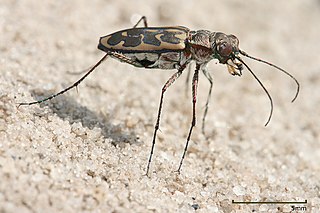
Tiger beetles are a family of beetles, Cicindelidae, known for their aggressive predatory habits and running speed. The fastest known species of tiger beetle, Rivacindela hudsoni, can run at a speed of 9 km/h, or about 125 body lengths per second. As of 2005, about 2,600 species and subspecies were known, with the richest diversity in the Oriental (Indo-Malayan) region, followed by the Neotropics. While historically treated as a subfamily of ground beetles (Carabidae) under the name Cicindelinae, several studies since 2020 indicated that they should be treated as a family, the Cicindelidae, which are a sister group to Carabidae within the Adephaga.

The soldier beetles (Cantharidae) are relatively soft-bodied, straight-sided beetles. They are cosmopolitan in distribution. One of the first described species has a color pattern reminiscent of the red coats of early British soldiers, hence the common name. They are also known commonly as leatherwings because of their soft elytra.

The rove beetles are a family (Staphylinidae) of beetles, primarily distinguished by their short elytra that typically leave more than half of their abdominal segments exposed. With roughly 63,000 species in thousands of genera, the group is currently recognized as the largest extant family of organisms. It is an ancient group, with fossilized rove beetles known from the Triassic, 200 million years ago, and possibly even earlier if the genus Leehermania proves to be a member of this family. They are an ecologically and morphologically diverse group of beetles, and commonly encountered in terrestrial ecosystems.
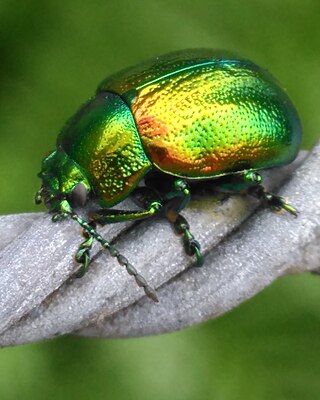
The tansy beetle is a species of leaf beetle. It measures 7.7–10.5 mm in length and has a characteristic bright metallic green colouration. The common name derives from the tansy plant on which they often feed as both larvae and adults. In addition to the nominotypical subspecies, which repeats the specific name, C. graminis graminis, there are five further distinct subspecies of tansy beetle, which, collectively, have a Palearctic distribution, although in the majority of countries where it is found the species is declining. In the United Kingdom it is designated as 'Nationally Rare' and this localised population, centred on York, North Yorkshire, has been the subject of much recent research.

The Anthicidae are a family of beetles that resemble ants. They are sometimes called ant-like flower beetles or ant-like beetles. The family comprises over 3,500 species in about 100 genera.
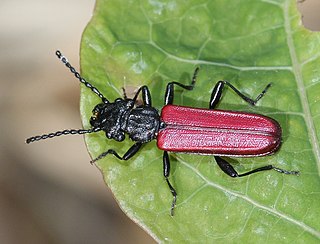
The Cucujidae, "flat bark beetles," are a family of distinctively flat beetles found worldwide under the bark of dead trees. The family has received considerable taxonomic attention in recent years and now consists of 70 species distributed in five genera. It was indicated Cucujus species are scavengers, only feeding on pupae and larvae of other insects and on other subcortical beetles such as their own. Since the Cucujidae prey on larvae of potentially tree damaging beetles that spread fungal diseases, they are considered to be beneficial to the health of living trees.

Staphylinoidea is a superfamily of beetles. It is a very large and diverse group with worldwide distribution.
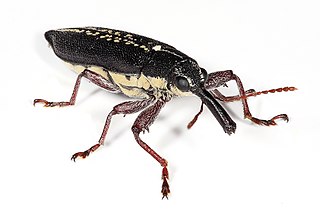
Belidae is a family of weevils, called belids or primitive weevils because they have straight antennae, unlike the "true weevils" or Curculionidae which have geniculate (elbowed) antennae. They are sometimes known as "cycad weevils", but this properly refers to a few species from the genera Parallocorynus and Rhopalotria.
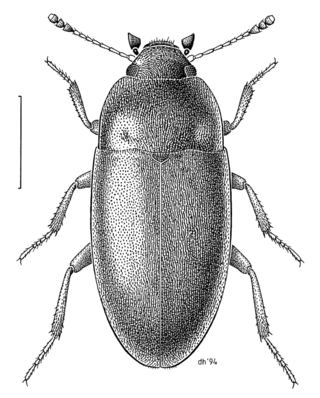
The family Archeocrypticidae is a small group of beetles with no vernacular common name, though recent authors have coined the name cryptic fungus beetles. Adults and larvae seems to be saprophagous and are often found in plant litter. Worldwide, about 10 genera and 50 species are found, most species are pantropical. Enneboeus caseyi has been recorded from the American South, Central America, and Mexico. About 20 species are found in Australia, in the genera Enneboeus,Australenneboeus and Gondwanenneboeus,Archeocrypticus,Falsoplatydema, Nothenneboeus, Sivacrypticus and Wattianus. They are largely absent from the Palearctic and Nearctic regions.

The family Pythidae is a small group of tenebrionoid beetles with no vernacular common name, though recent authors have coined the name dead log bark beetles. There are seven genera, which are largely native to the mid-high latitude regions of the Northern Hemisphere and Australia, with one genus also present in the tropical Americas. The larvae are generally found with decaying vegetation and wood on which they feed, while adults are not associated with the larvae and are generally caught using malaise traps and light traps.

The family Scraptiidae is a small group of tenebrionoid beetles sometimes called false flower beetles. There are about 400 species in 30 genera with a world-wide distribution. The adults are found on flowers, sometimes in large numbers, but are also found on foliage. The larvae are typically found under the bark of dead trees. The oldest fossils of the group date to the Eocene.

Cleridae are a family of beetles of the superfamily Cleroidea. They are commonly known as checkered beetles. The family Cleridae has a worldwide distribution, and a variety of habitats and feeding preferences.

Ptiliidae is a family of very tiny beetles with a cosmopolitan distribution. This family contains the smallest of all beetles, with a length when fully grown of 0.3–4.0 millimetres (0.01–0.16 in). The weight is approximately 0.4 milligrams. They are colloquially called featherwing beetles, because the hindwings are narrow and feathery. Ptillid wings are feathery due to the much higher effective viscosity of air at small body sizes, which makes normal insect wings much less efficient. Unlike other small insects with feathery wings, such as parasitic wasps like fairyflies, ptillids do not fly using a clap and fling motion, but instead fly using a figure of eight pattern where the wings clap at the apex of the upward and downward strokes. They are capable of flying at speeds comparable to their larger relatives.

Spider beetles make up the subfamily Ptininae, in the family Ptinidae. There are approximately 70 genera and 600 species in the subfamily, with about 12 genera and 70 species in North America north of Mexico.

Hygrobia is a genus of aquatic beetles native to Europe, North Africa, China and Australia. It is the only genus in the family Hygrobiidae, also known as the Paelobiidae. These are known commonly as squeak beetles or screech-beetles.

The Trictenotomidae are a small family of beetles in the superfamily Tenebrionoidea, containing fifteen species in two genera. Most species are found in the Oriental realm where they live in montane forest habitats. The family is considered, based on larval characters as well as sequence-based studies, to be closely related to the Salpingidae.

Hydrophilus piceus is a species of beetles in the family Hydrophilidae, the water scavenger beetles. This very large aquatic beetle is found in the Palearctic and is known by the common name great silver water beetle.

Gibbium aequinoctiale, the smooth spider beetle, is a species of spider beetle in the family Ptinidae. It is found in the Caribbean, Europe and Northern Asia, Central America, North America, and South America. It has been reported from many parts of the world as Gibbium psylloides.

Gibbium psylloides, also known as the hump beetle or the smooth spider beetle, is a species of spider beetle in the genus Gibbium. It is native to the Palearctic, Southeast Asia, and North Africa. It was first described by Paweł Czenpiński in 1778. North American references to G. psylloides actually refer to Gibbium aequinoctiale.
Carl Hildebrand Lindroth was a Swedish entomologist and a professor at Lund University. He was a specialist in carabidology, with a special interest in biogeography. He was a strong proponent of the glacial refugium hypothesis and made use of the framework to explain the distribution patterns of Scandinavian beetles.